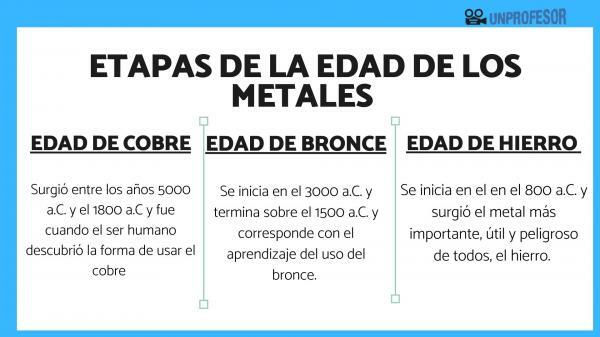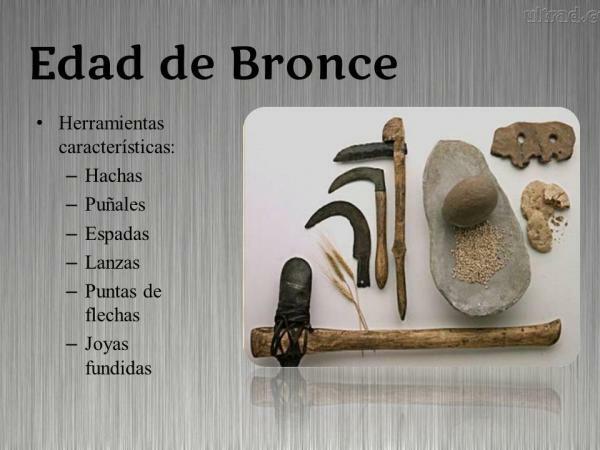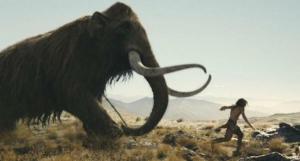STAGES of the METAL Age: Copper, Bronze and Iron

The divisions used throughout the history of humanity also existed in the early phases of our existence, a clear example being the divisions used in prehistory. Unlike other times, in Prehistory we can make temporal divisions depending on the type of material predominant, such as stone or iron. To know these divisions in this lesson from a Teacher we must talk about the stages of the Metal Age.
Index
- What are the 3 stages of the Metal Age?
- Copper Age
- Bronze Age
- Iron age
What are the 3 stages of the Metal Age?
The Age of metals It is a very broad period of Prehistory that goes from the beginning of human history, when we were still nomadic tribes, to settlements and first civilizations based on agriculture and livestock.
Due to the enormous evolution that took place during these years, historians have differentiated 3 stages of the Metal Age that vary depending on the metal used in each one of them. The 3 stages are:
- Copper Age
- Bronze Age
- Iron age
Next, we are going to analyze each of these three stages in more detail so that you know their features and the most outstanding facts.
Copper Age.
We must bear in mind that the Metal Age is the way in which Prehistory is divided in Europe, Asia and Africa, suffering variations in other regions. The first of these divisions is that of the Copper Age, being also known as Chalcolithic or Eneolithic and taking place between the years 5000 a. C. and 1800 a. C. It is the time when the human being discovered how to use copper for your society.
At first, human beings used copper in a primitive way, using it in a traditional way or changing it through blows. But over the years they realized that the simplest and most useful way to handle metal was melt it, and even mix it with other elements, showing that it was a very important metal for a society that knew how to use it.
There is a tendency to consider the Copper Age as a huge transition between human times, since they went from using stone as a material for everything, to also using copper and beginning to understand how metals worked, which over the years was essential for human evolution.
Regarding its use, it is thought that the first great civilizations of the world already used copper, since peoples like the Sumerians or Ancient Egypt seem to have had great knowledge to produce with this material; although other important areas such as China or Japan seem not to have had this period.

Bronze Age.
The second of the stages of the Metal Age is known as Bronze Age, being the stage in which humans discovered how to work with bronze and, for this reason, they put aside the use and manipulation of copper.
Bronze is an alloy of tin and copper, and therefore we must understand that its use stems from an enormous improvement in the treatment of copper. The one known as the Bronze Age It begins in 3000 BC. C. and ends about 1500 BC. C., being the period in which this material was started to use in Egypt and Mesopotamia, being the places from where they spread to all prehistoric society.
The Bronze Age was the first time that metal played a relevant role in the military life, weapons made of bronze were more dangerous than stone ones, causing those made of bronze to societies with weapons of this material were more dangerous and could more easily take other regions.
In addition to the use of bronze This stage of Prehistory was marked by the emergence of important defining elements of what would later become the Old age, as was slavery, urban centers and the emergence of a more efficient trade thanks to bronze.

Iron Age.
To end this lesson on the stages of the Metal Age, we must explain the last of them known as the Iron age, a time when human society undergoes such a change that it serves as a precedent for the Ancient Age. In this period, the most important, useful and dangerous metal of all, iron, emerged, changing the lives of the prehistoric people forever.
Human beings had known iron for years, but were unable to manage it because they did not know the mechanisms for manipulating the metal. The origin of the Iron Age the moment when it was discovered how metal worked. We can find this origin in 800 a. C., thus initiating the Iron Age that would not end until the origin of classical civilizations and therefore with the beginning of the Ancient Age.
One of the main uses of iron was for improve agricultural production, achieving enormous advances in this field and thus causing a greater population to exist, since if the resources were greater they could be consumed by a greater number of people.
The Iron Age it did not happen at the same time in all societies prehistoric, varying the year depending on numerous factors and causing the beginning of the Ancient Age to vary depending on it. In Europe we can say that it spanned the Greek Dark Ages and ended with the passage to the polis; in India it happened at the time of Vedism and ends with the appearance of Buddhism; while in China it begins during the Zhou dynasty and ends with the beginning of Confucianism.

Image: A corner for history
If you want to read more articles similar to Stages of the Metal Age, we recommend that you enter our category of History.
Bibliography
- Arce García, A., Arnáiz Martínez, M., Barrio Rodríguez, J., Bellostas Sagredo, P., Burón García, N., Jodra Esteban, P.,... & Urquiza González, M. (1993). Neolithic and Metal Age.
- Coetzee, J. M. (2013). The iron age. DEBOLS! LLO.
- Bosch-Gimpera, P. (1954). The Bronze Age of the Iberian Peninsula. Spanish Archive of Archeology, 27 (89), 45.



